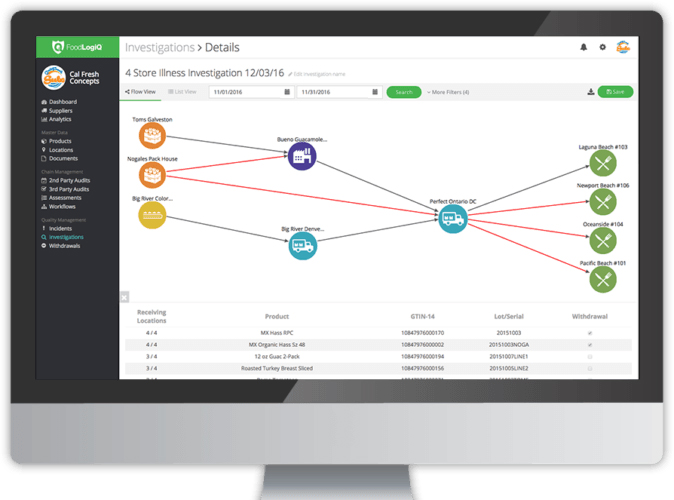The last 18 months have been tremendously difficult for the restaurant industry. Six years of growth were undone by a global pandemic, and industry sales were $240 billion dollars lower than pre-COVID-19 projections, according to the National Restaurant Association.
While the pandemic accelerated the adoption of trends like online ordering, off-premise dining and delivery, it also brought others to a halt. Revenue loss from the pandemic meant many restaurants had to put other technology upgrades on hold.
Now, despite diners eagerly returning to dine in, other costs have not returned to pre-pandemic levels. Supply chain and labor disruptions, rent, and other operational costs are still making margins razor thin. This likely means the technology teams at many brands will be looking to do more with less for several years as the industry normalizes again. And oftentimes that means food safety will take a back seat.
Traditional ways of trimming budgets are no longer feasible, so operators looking to restore profitability will need to find new ways to boost operational efficiencies. These challenges do not mean you can’t make strategic investments, but they do mean you will have to be thoughtful about how and where you put those tech budgets.
Operators are facing a number of challenges while trying to regain their footing as COVID restrictions wind down. However, there are ways you can still invest in food safety technology, even while profits are recovering. Let’s look at what roadblocks are potentially introducing risk into your food safety program and how you can still create an effective food safety culture to protect employees and guests.
The Challenges
The following are just a few of the issues introducing risk into your food safety processes.
Challenge 1: Staffing shortages have employees spread thin.
Many people left the restaurant industry during the pandemic, exacerbating an already tight labor market. This has led to closing for some days or specific times, slower service, drive thru or take out only, and routine tasks falling behind.
While safe food handling should be routine, time crunches put pressure on even the best staff. Your employees may be fudging line checks, not throwing out food that reached unsafe temperatures, or forgetting specific tasks at the busiest times.
Challenge 2: Supply chain and transportation disruptions threaten safe food supplies.
Global supply chains are still fluctuating, and transportation has been disrupted as well. This means many restaurants are not getting the entire inventory they need when they need it. Trucks may take longer to transport food and high temperatures across North America could mean food is going out of temp when it normally wouldn’t. This is particularly troubling if employees aren’t checking deliveries, as you won’t know if food has been delivered outside safe temperatures.
Challenge 3: Dropping revenue leads to more manual processes and temp checks.
According to the National Restaurant Association’s annual report, 86% of restaurants say profitability is lower than it was prior to the pandemic. This is not an unexpected statistic in a year that saw unprecedented challenges to the industry, but it has had a number of domino effects.
One of those effects is restaurants that may previously have been using operational software to monitor and report on safe food practices returned to spreadsheets or clipboards to save on tech costs. Or those that had smart devices such as Bluetooth temperature probes or fridge and freezer monitors replaced them with non-smart devices if they broke or became out of date.
Challenge 4: Employee turnover threatens food safety culture and institutional knowledge.
It’s no secret that a food handler’s permit is not the end-all-be-all of food safety in a restaurant. The longer employees work in foodservice, the more experience they have with safe food handling practices, and they are able to pass this down to new employees to reinforce best practices.
However, the loss of many longtime foodservice employees leaving the industry has left huge gaps in institutional knowledge that affect everything from how smoothly a restaurant runs to how well employees follow safe food handling.
The Solutions
There is no one-size-fits-all solution for every restaurant. However, here are a few things operators can focus on to help bolster food safety practices and bring in modern food safety technology even while profitability is lower than it was prior to the pandemic.
Solution 1: Look for improvements in existing processes or technology.
You don’t have to immediately look to new technology. There is a lot to be gained from optimizing what you already have that’s working well. This can mean looking for new ways to take advantage of technology you already have in place or making small adjustments to processes that work well but could be tweaked to be more efficient.
For example, if you are using some sort of digital checklist tool, think about ways you can integrate a previously manual food safety process into it. You may not think it’s a big change, but even skipping the step of having to transcribe data from checklists or spreadsheets means you will get faster, more accurate reporting. Or you can use existing temperature probes and add the step of checking deliveries as they arrive to ensure they are within a safe temperature range.
Then talk to the customer success manager at any company you already use. There may be features you are paying for and don’t even realize you aren’t using. One example is that many inventory systems also carry food safety capabilities as a side offering, and their customers aren’t using it because they originally signed up for inventory help.
You can begin with seemingly small changes that will ultimately add up to a big reduction in risk as you snowball strategies and build safer processes.
Solution 2: Look for places where you can consolidate technology.
In today’s restaurant technology ecosystem, you can find virtually anything you want. If you’ve been building a piecemeal tech stack, it’s time to take another look at what’s out there. Many restaurants are paying for separate software for things like operations checklists, inventory, food safety, scheduling and training.
If you’re using separate systems because you feel like that’s giving you the best technology, then carry on. But if it’s just because that’s how you added them, and you never took a look at where you could consolidate multiple systems into one platform, then get acquainted with your options. Many back-of-house platforms can help you cover multiple areas of your operations more efficiently and you’ll be able to bundle pricing rather than paying for disparate systems.
Solution 3: Focus on systems that pay for themselves.
The idea that software is only a cost center has been around for a long time. Some systems may not tie back directly to revenue, but there are more places than you realize that cover their own subscription costs with the money saved.
First, look for any areas you can consolidate technology and piggyback food safety tools into that. If you are gaining a new restaurant management system, odds are you will find food safety technology as part of that package, and you can justify the overall upgrade on food and labor savings.
Second, food safety is so reliant on employee buy-in and consistency that technology that improves retention and training will also have a positive effect on your food safety risk reduction. Labor management and scheduling systems will bring down one of the two major costs of running a restaurant, with a secondary benefit of making food safety practices stronger.
The longer you retain employees, the better they are at teaching correct practices to others as well as adhering to brand food safety practices. Plus, training systems that come with labor tools allow you to provide micro learning moments that reinforce proper practices for even the most experienced employees.
Life during the pandemic has taken a toll on all areas of restaurant operations, including food safety. Now that guests are dining out more, you don’t want to take a chance that a foodborne illness will destroy business just as it is being rebuilt. Times are tight to pay for new technology, but there are things operators can do to make food safety programs stronger without breaking the bank.







